Art, throughout the ages, has served as a powerful medium for artists to convey their innermost thoughts, struggles, and reflections on the world around them. In this exploration, we delve into the captivating narratives behind 15 iconic artworks in art history, each a unique window into the minds of their creators.
1. “Starry Night” by Vincent van Gogh
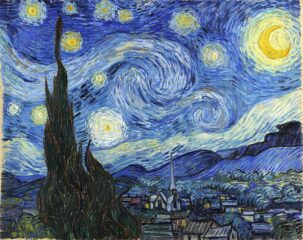
A Celestial Canvas of Turmoil
Vincent van Gogh’s ‘Starry Night’ is a famous artwork that portrays swirling cosmic patterns, symbolizing the artist’s mental struggles and inner turmoil. It seamlessly blends reality and imagination, capturing a poignant mix of beauty and chaos.
2. “The Last Supper” by Leonardo da Vinci

A Divine Tapestry of Betrayal and Spirituality
Leonardo da Vinci’s “The Last Supper” is a divine tapestry brimming with religious symbolism, seamlessly bridging the earthly and divine realms. Moreover, this masterpiece immortalizes Christ’s announcement of betrayal, embodying the profound depth found in iconic artworks.
3. “Guernica” by Pablo Picasso
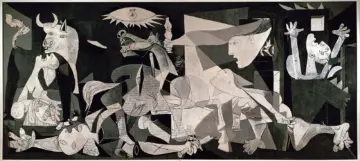
Echoes of War’s Horrors
Pablo Picasso’s “Guernica” expertly portrays the horrific realities of war, specifically the devastating bombing of Guernica during the Spanish Civil War. Using captivating artworks, Picasso creates a visual symphony that immerses us in the haunting aftermath of destruction.
4. “The Persistence of Memory” by Salvador Dalí
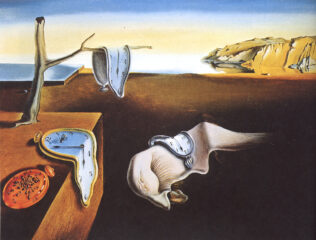
A Surreal Exploration of Time
Salvador Dalí’s “The Persistence of Memory” challenges our perception of time and reality through surreal landscapes and melting clocks. Moreover, this masterpiece invites us to reflect on the fluidity of time and offers an otherworldly experience. Additionally, it is a profound example of how art provokes contemplation on the nature of existence.
5. “The Scream” by Edvard Munch
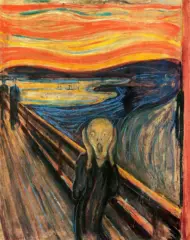
A Cry of Existential Angst
Edvard Munch’s artworks, including “The Scream,” are iconic representations of existential angst and the pervasive anxiety of modern life. Furthermore, through distorted figures and a vivid, swirling sky, Munch encapsulates the profound unease that echoes through the human experience, thus making a powerful statement about the fragility of our existence.
6. “The Death of Sardanapalus” by Eugène Delacroix
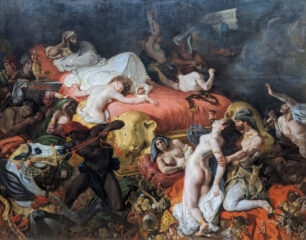
A Spectacle of Decadence and Destruction
Eugène Delacroix’s “The Death of Sardanapalus” is an artwork that portrays the dramatic downfall of an Assyrian king, capturing themes of decadence and destruction. Additionally, with a vivid palette and dynamic composition, Delacroix further immerses us in the chaotic spectacle, symbolizing the inevitable collapse of excess and indulgence.
7. “The Weeping Woman” by Pablo Picasso

Silent Suffering in Times of Conflict
The Weeping Woman, an iconic image of unspeakable grief and pain, represents universal suffering. Moreover, the fragmented features, along with the use of acid green and purple, further enhance the painting’s emotional intensity. Additionally, it is noteworthy that Picasso’s partner, Dora Maar, served as the model for this painting. Furthermore, Dora Maar, a passionate, strong, and intelligent woman, brought her own unique essence to the artworks.
8. “Les Demoiselles d’Avignon” by Pablo Picasso
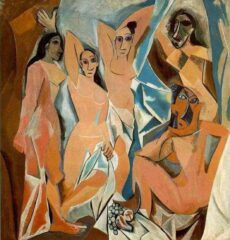
Redefining Beauty and Sexuality
In ‘Les Demoiselles d’Avignon,’ Picasso challenges traditional notions of beauty and sexuality using angular and distorted forms. In doing so, he boldly redefines aesthetic norms, ushering in a new era of artistic expression that dares to question societal expectations. Moreover, this groundbreaking work signals a departure from conventional artistic styles, paving the way for a revolutionary movement in the art world.
9.”The Elephants” by Salvador Dalí

Cosmic Fragility and the Weight of the World
Salvador Dalí’s “The Elephants” carries a weighty symbolism, representing both the cosmic fragility of existence and the burdensome weight of the world. Additionally, through surreal imagery, Dalí invites us to ponder the delicate balance between strength and vulnerability in the grand tapestry of the universe.
10. “The Broken Column” by Frida Kahlo

A Chronicle of Physical and Emotional Pain
Frida Kahlo’s “The Broken Column” vividly depicts her physical and emotional pain after a severe accident. Transitioning from the external to the internal, this powerful self-portrait chronicles resilience in the face of profound suffering. Additionally, Kahlo’s meticulous depiction invites viewers to empathize with her emotional journey embedded in the artworks.
11. “The Son of Man” by René Magritte
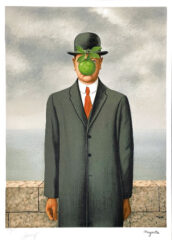
Unveiling Hidden Identities and Self-Perception
René Magritte’s “The Son of Man” invites us into the enigmatic world of hidden identities and self-perception. Moreover, through the iconic apple-obscured face, Magritte prompts us to question the masks we wear, challenging us to unveil the layers that shape our understanding of ourselves.
12. “The Birth of Venus” by Sandro Botticelli
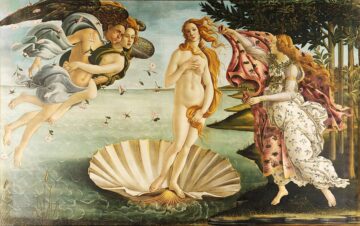
A Celebration of Classical Beauty and Love
Sandro Botticelli’s “The Birth of Venus” is a timeless celebration of classical beauty and love. With graceful strokes, Botticelli vividly portrays the goddess emerging from the sea, embodying enduring ideals of beauty, love, and purity. Moreover, this masterpiece captivates viewers across different eras, showcasing how art can encapsulate timeless themes.
13. “The Night Watch” by Rembrandt
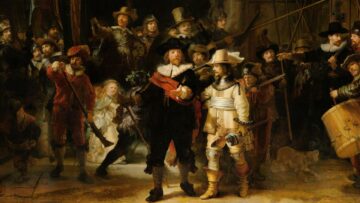
A Dramatic Canvas of Human Interactions
Rembrandt’s “The Night Watch” not only captures a dynamic tableau of human interactions, but it also pulsates with movement and drama. Additionally, through a masterful play of light and shadow, Rembrandt immerses us in a complex narrative that unravels the intricacies of human relationships. Adding more transition words, in fact, emphasizes the seamless flow of ideas and enhances the overall coherence of the statement.
14. “Nighthawks” by Edward Hopper
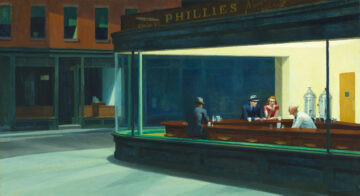
Urban Isolation and Modern Emptiness
Edward Hopper’s “Nighthawks” elicits a profound sense of urban isolation and emptiness of modern life. Additionally, through a play of light and shadow in a diner at night, Hopper invites us to reflect on the isolation that can persist even amidst bustling urban landscapes.
15. “Les Misérables” by Banksy

A Street Art Manifesto on Social Issues
Banksy’s “Les Misérables” is not only a thought-provoking street art piece but also an engaging portrayal of social issues, poverty, and the plight of the less fortunate. Transitioning from traditional canvases to public spaces, Banksy’s work not only challenges societal norms but also serves as a poignant manifesto for change. Additionally, through his distinctive style and use of unconventional mediums, Banksy effectively transforms the urban landscape into a canvas for activism. As viewers encounter his pieces, they are urged to confront and reconsider prevailing social injustices.
These masterpieces, each a unique testament to the artist’s vision and expression, serve as windows into the human experience. Furthermore, through the brushstrokes and canvases, artists throughout history have eloquently conveyed the complexities of life. In addition, this invitation allows us to reflect on our own existence and the profound beauty that resides within the realms of art.


